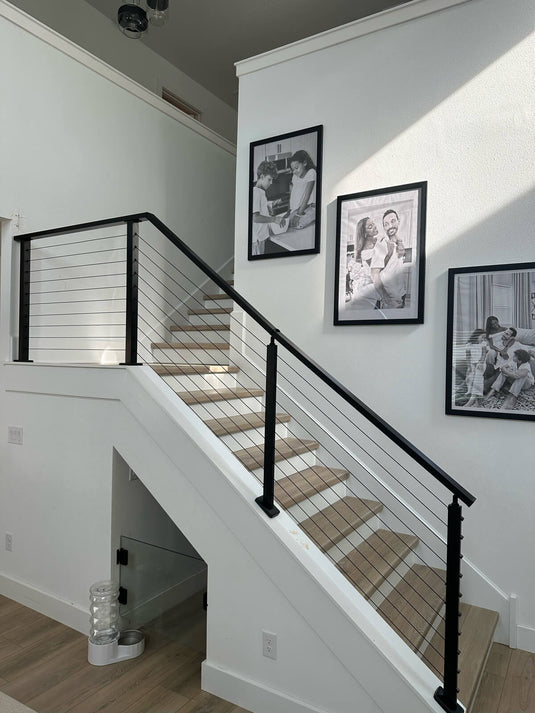TABLE OF CONTENTS
Choosing the Right Railing Cable Thickness: A Guide to Safety and Style
So you've settled on a cable railing for your stairs or deck—excellent decision! Now you must decide on a critical detail: how thick should the cable be? It might seem a small thing, but the choice affects the overall look of the railing, its overall cost, and most critically, its safety. This guide will explain the standard options, cover the pros and cons, and help you choose the perfect cable for your project with confidence.

What Exactly Is This Railing Cable?
Prior to getting into thickness, it helps to know what you're actually working with. Railing wire isn't some off-the-shelf cable you'd find at the hardware store. It's tailored, high-quality product for just this use.
Just about any railing cable you come across will be constructed of Grade 316 stainless steel. This is a good grade because it's really good at resisting rust, which makes it the number one choice when working on outdoor projects, particularly if you're located near the ocean.
And how the cable is constructed makes a difference, too. You'll nearly always hear it referred to as "1x19" construction. All that refers to is that one heavy strand is constructed from 19 smaller wires that are twisted together. This construction is significant because it's extremely stiff and hardly stretches at all, which keeps your railing tight and secure for years to come.
The Main Choices for Railing Cable Thickness
When you start shopping, you'll see three main thicknesses pretty much everywhere. They might look similar from a few feet away, but they each have their own purpose.
This is, by far, the most popular choice for homes. A 1/8" cable gives you that super clean, minimal look that almost vanishes from a distance, which is perfect if you don't want to block your view. It's also the most budget-friendly option for both the cable and the hardware that goes with it. And even though it's thin, it's incredibly strong, with a typical breaking strength of over 1,700 pounds.
Stepping up to a 3/16" cable gives you a more solid look and feel, but it's not so thick that it looks out of place. This size is a fantastic middle ground. It has a much higher breaking strength (around 4,000 pounds) and is less likely to feel flimsy over long stretches. Many people choose 3/16" cable for a sturdier feel, for railings with posts spaced far apart, or for commercial projects with stricter rules.
The 1/4" cable is the thickest you'll normally see for railings. It gives you a bold, industrial vibe and is unbelievably strong, with a breaking strength often over 7,000 pounds. This size has almost no flex at all, even over long distances. You’ll mostly see it used in commercial projects or in home designs where the cable itself is meant to be a major style element. The hardware for it is also bigger and more expensive.

How to Pick the Right Railing Cable Thickness for Your Job
So, which one should you get? For almost all home deck and stair projects, 1/8" railing cable is the perfect choice. It's more than strong enough to pass safety codes, gives you the cleanest look, and is the easiest on your wallet.
That said, the best choice for you depends on a few things. Here’s how to decide:
- The Look You Want: This is all up to you. Do you want the cables to practically disappear? Go with 1/8". Do you like a tougher, more industrial look where the cables are part of the style? Then 3/16" or even 1/4" is your answer.
- Your Posts and Spacing: How far apart your posts are really matters. If your posts are spaced far apart (like 5 feet or more), a thicker 3/16" cable can help keep things from feeling flimsy. If you're using wood posts, which can bend a little under tension, a 3/16" cable also adds some extra stiffness. For most sturdy metal post systems, 1/8" is perfect.
- Your Budget: Don't forget, a thicker cable costs more per foot, and all the little fittings and tensioners that go with it are more expensive too. If you need to keep costs down, the 1/8" standard is your best bet.
Is a Thicker Cable Always a Safer Cable?

Many people believe this, but it's not entirely correct. Although a thicker cable is stronger technically, that does not necessarily mean the entire railing system is safer. A cable railing is made safe by the complete system—the posts, the tension, and the cable—all functioning together.
A properly installed railing with 1/8" cable that's properly tensioned and attached to strong, solidly mounted posts is far safer than a railing with heavier 3/16" cable that's sagging or attached to weak posts. The most important things for safety are the integrity of your posts, how well they're attached to your deck frame, and getting proper tension. Cable diameter is just one component of the equation.
Finally, the choice of your railing cable diameter is a compromise between your style, your budget, and your project requirements. While 1/in cable is the norm for most homes, a 3/16" cable is a great upgrade if you want that extra-solid feel. Whatever you choose, make a quality installation the priority—that's the real secret to a beautiful, safe railing that will last a lifetime.




